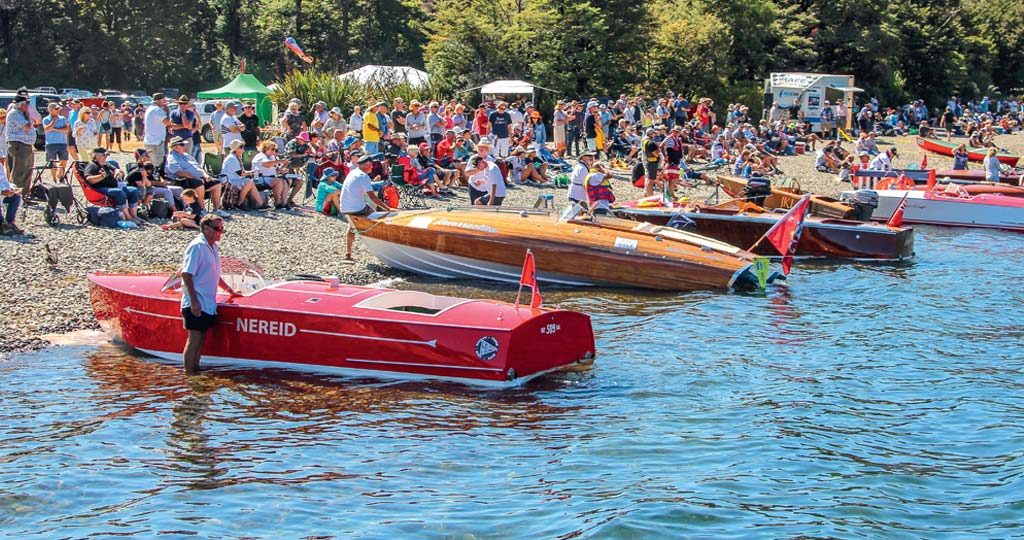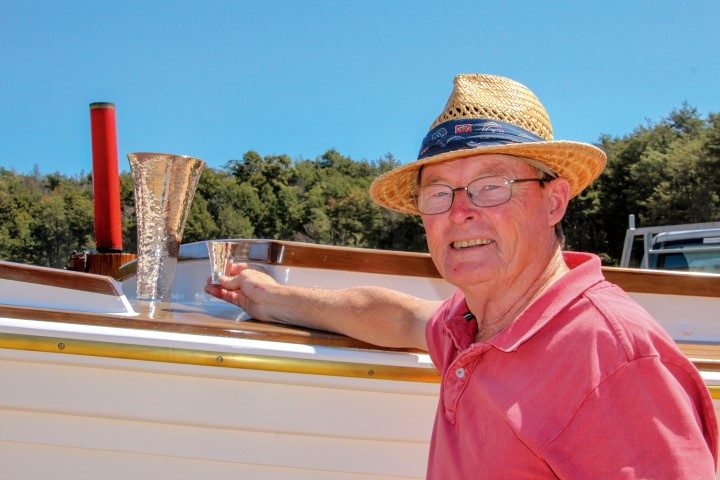

A fleet of 130 clinkers, steam launches, sailing dinghies and mid-19th century speedboats glided, roared and gurgled on Lake Rotoiti at last month’s Antique & Classic Boat Show. The 3000-strong crowd adored them. Rebecca Hayter was there.
The hammered-silver Jens Hansen Cup for Best Boat Overall graced the foredeck of the 20ft 10in Aurora, an amateur-restored, 1935 open clinker boat. Behind the hard work was owner and restorer David Gollop.
David had a career in flight operations at Air New Zealand in Nelson but his hobby – he calls it therapy – was restoring old boats. His earlier projects included restoring a Stewart 34 and building a 30ft Pelin Patrol but he always wanted to do a big, open wooden boat.
“When I found her she was in a sorry state in an old shed in Hope but I didn’t even have to get out of the car,” he says. “There was no question I had to have it.”

That was February 2011 in rural Nelson. She was upsidedown on an unsprung trailer. David trucked her home to Redwood Valley and put her on a trolley he’d made in his shed.
There was no rudder or engine. Many of the planks were split; half the keel was missing. David built a new keel in laminated macrocarpa, replaced most of the copper fastenings and rebuilt the transom.
After three years, fitting boat work in between other commitments, David had sanded and painted the outer hull to perfection but when he turned her over, the inside was still a mess. It was like starting all over again.
He scraped away years of old primer and top coats, shaped the floor frames, fitted a new bronze shaft log and engine mounts. Recycled kauri came from ceiling beams from Matamata and floor joists from a house demolition in Tauranga. “The floor joists had nail holes. I didn’t try to hide that because they were part of the character of age,” says David. “I didn’t go overboard trying to make it look antique.”
He removed the decking back to the frames and replaced it with three layers of laminated, 4mm plywood as the base with 6mm kauri strips, steamed where necessary, glued on top. To design the rudder, he researched 1930s boating pictures. “I built it and cut it down at least twice until I thought it looked right.”

As originally built in 1935 at Port Nelson, Aurora was a lighter to tender explosives from the magazine on the Boulder Bank for reconstruction work on Rocks Road. She had no engine, possibly because stacking explosives either side of a petrol engine is not smart. Instead, small power boats pushed her and her volatile cargo to Rocks Road.
In later life, Aurora was powered, but she was engine-less when David bought her. He sourced an overhauled Stuart Turner P55M 8hp petrol motor from Golden Bay and designed a freshwater cooling system with copper pipes running beneath the hull.
“I don’t want sea water coming through the engine,” he says. He estimates her speed at 6 knots.
Atop the centre thwart are two charming, round tanks painted in Hawthorn Green, custom-made by Stainless Solutions in stainless steel. One is the petrol tank; the other is for the cooling water. David considered hiding them under the front coaming but decided 1930s thinking would have preferred a simple installation. The water tank’s retro style temperature gauge from TradeMe was just perfect.
“It’s a good honest work boat and that’s what I wanted it to look like,” says David.
The judges agreed and honoured the hard slog of an amateur restoration. Event director Pete Rainey says Aurora captures the essence of the event.
“The Jens Hansen trophy for Best Vessel Overall has gone to all sorts of boats from perfectly restored craft to real workhorses of the sea,” he says. “Aurora will be familiar to older Nelsonians. When her work as an explosives tender was done, she became an excursion boat for trips to Haulashore Island and the lighthouse and was then handed over to the Sea Scouts.”
Cost-wise, the trailer represented almost as much as the boat. David modified the unsprung trailer and had it blasted, arc-sprayed and clear-sealed at Galbraith Sandblasting and Powdercoating in Nelson to complement Aurora’s looks.
FINESSE – BEST NEW CRAFT
A replica of a 19ft Chris-Craft racing runabout got the gong for the Show’s Best New Craft. And as owner/builder Troy Deavoll explains, his inspiration came from My Love – a similar ChrisCraft he spied at the 2015 Nelson Antique and Classic Boat Show. He was smitten by the apple pie of retro American boating and decided to build one. Finesse is the result.

On her first outing – at this year’s show – she proved to be a crowd favourite, also winning the People’s Choice Award. And Johnny Malthus – My Love’s owner and restorer – says Finesse is the best built Chris-Craft he’s ever seen.
And that can happen when a cabinetmaker builds a boat.
138 YEARS OF CHRIS-CRAFT
In 1861, Abraham Lincoln became president, the American Civil War broke out and Christopher Columbus Smith was born in St Clair County, Michigan. Chris Smith built his first boat aged 13 and opened a boatbuilding yard with his brother Hank in 1881.
They built rowboats, sailboats and steam-powered launches for affluent businessmen. When the internal combustion engine arrived around the turn of the century, Chris Smith saw its potential for boats, just as Henry Ford was figuring out how to power wheeled vehicles.
The Smith brothers’ first speedboat was powered by a 2hp Stens engine and achieved a then-blistering 7mph. Chris realised that higher speeds required a dynamic re-think of hull shape. Six years in a row, up to 1921, his boats won the Gold Cup at the American Powerboat Association Race.
By then customers had nicknamed the boats Chris-Craft and the company made it official in 1924.
In the late 1920s, Chris-Craft became one of the first mass-producers of civilian pleasure boats and offered them on installment plans. Lake boats were no longer a rich man’s privilege. They were usually powered by Ford and Chrysler and, later, Hercules engines.
Chris-Craft survived the Great Depression with the introduction of low-priced powerboats. Chris Smith died in 1939. Under his son’s management, Chris-Craft built small patrol boats and more than 10,000 military landing craft, including some used at the Normandy Landing in 1944. The heyday came in the 1950s when Chris-Craft offered 159 models, often featuring liberal use of mahogany, teak, and brass.

Chris-Craft manufactured its first fibreglass boat in 1955. It moved to Florida in the 1960s and built its last wooden boat in 1972. ChrisCraft was bought by Winnebago Industries in 2018.
Chris-Craft owners have included Dean Martin, Kathryn Hepburn, Frank Sinatra and Elvis Presley and even the boats have starred in movies. Henry Fonda crashed a replica 1950 Chris-Craft Sportsman in On Golden Pond (1981) and Bruce Willis chased the bad guy in a 1956 Chris-Craft 21-foot Capri in Striking Distance (1993).
MY LOVE – DEAVOLL’S INSPIRATION
Johnny Malthus’ My Love was built in Michigan in 1947, hull number 35 of 205 originally built, and spent her American life in upstate New York. Johnny found her eight years ago on eBay, on his second attempt. The first time he found a boat on eBay, he contacted USA Classic Boat America to find a broker who could arrange a survey. “It failed miserably,” Johnny says.
The second boat did better. “This one was sweet. I bought it sight unseen but subject to survey.”
He did a full restoration, including some original planking and frames using WEST System. She was built in Spanish cedar, a lightweight timber, on mahogany frames. Power was a 148hp ML Hercules, bought as army surplus by Chris-Craft and marinised.

Prior to WWII, Chris-Craft painted the model blue and white; after the War the model was red and white, possibly in tribute to blood lost by American soldiers.
Johnny named his boat My Love for his wife but it has a bonus. “When a waterskier falls off, it’s always the driver’s fault,” he says. “But if the skier yells out their sentence starting with ‘My Love’, it is clear there is no anger towards the driver.”
Forget about being towed by My Love: I got a ride in the front seat for the main race. There was a thrumbling roar; the speed was smooth and solid and just for a second I glimpsed the American dream.
20 YEARS OF CLASSICS
This year’s Antique and Classic Boat Show at Lake Rotoiti in the Nelson Lakes National Park celebrates 20 years of the beautiful and the bizarre among Kiwi heritage boats.
At 640m above sea level it’s New Zealand’s highest altitude boating event, with the fine craftsmanship and unusual entries continuing to attract the crowds.
Organiser Pete Rainey says boat owners are willing to admit it is a bit mad to hunt down old boats abandoned in sheds and spend years sanding, polishing and tracing boat history and boat bits.

“Over the years we’ve seen different styles to the fore – sometimes it’s been jet boats, sometimes clinkers and now we’re seeing a real interest in the big classic speedboats from mid-19th century, some imported and some New Zealand-built.
“The boat show’s consistent factors are the enthusiasm from boat lovers for a day out sharing their projects, the attraction this has for the wider public, and the really glorious setting on Lake Rotoiti’s shore with the backdrop of the St Arnaud range and Mt Robert.”
For more information visit www.nzclassicboats.com
LAKE ROTOITI AWARD WINNERS
BEST BOAT OVERALL
David Gollop, Nelson, 20ft clinker Aurora
BEST NEW CRAFT
Troy Deavoll, Christchurch, 19ft Chris-Craft Finesse
BEST RESTORATION PRIZE
Russell & Janet Cloake, Mossburn, 12ft inboard dinghy Little Honey
PORT NELSON ROWED CRAFT TROPHY Zonder Gifford, Nelson, 13ft self-built dinghy
CWF HAMILTON JET-PROPELLED CRAFT TROPHY
Ed Wicken & Paul Mullen, Christchurch, wooden-hulled 1957 jet boat
JOHNSON FAMILY SAIL-POWERED CRAFT TROPHY
Stephen Jarvis, Christchurch, 1930s clinker ketch
MATHIESON JEFFCOTT MOTOR-POWERED CRAFT TROPHY
Shane Warland, Nelson, 21ft diesel launch
OUTBOARD MOTOR BOAT PRIZE
Steve Pellet, Blenheim, 18ft 1963 Beattie cabin top
RON CULLEY STEAM BOAT TROPHY
Bob & Sue Hamlett, from Wellington for 1984 RMS Flirt




